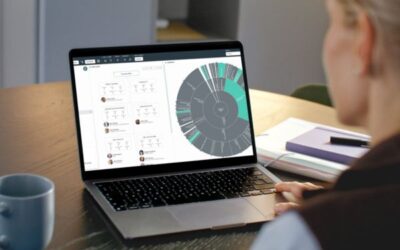Workforce analytics trends defined & why are they important?
Workforce analytics trends refer to the patterns and insights derived from the analysis of various aspects of a company’s workforce. These encompass a wide array of metrics, including but not limited to headcount, diversity, mobility and performance. Tracking these trends is vital as it offers invaluable insights into workforce dynamics, enabling organisations to make data-driven decisions.
Overall, workforce analytics trends play a crucial role in enhancing overall business success by enabling organisations to:
- Proactively identify and mitigate risks;
- Allocate resources more effectively;
- Strategically manage talent;
- Continuously monitor and improve performance;
- Manage compliance risks.
By leveraging workforce analytics insights, organisations can build a more resilient workforce capable of thriving in an ever-changing business landscape.
Workforce trends dashboard example
This example is a best practice workforce trends dashboard in org.manager, a solution that allows you to visualise all of your important HR metrics in a single (real-time) visualisation.
To give you some inspiration around useful information to show in a workforce analytics trends dashboard, here’s 3 different views:
- Headcount/FTE Trends: A month-on-month graphical representation of headcount and position trends. It gives a summary of vacant positions, new employees in the current and past financial year as well as employee turnover in the current and past financial year.
- Diversity KPIs: See important diversity metrics, including gender and age distribution over time. Understanding diversity trends is crucial for fostering an inclusive workplace culture, succession planning and ensuring equitable opportunities for all employees.
- Mobility Insights: Displays trends such as new employees and turnover rates. Tracking mobility trends enables organisations to assess talent retention strategies and identify opportunities for career development and succession planning
Tip: This view can be completely customised based on your business requirements; therefore you can display any data point that you store internally (from almost any source).
How a workforce analytics trends dashboard will improve your business
Implementing a workforce analytics trends dashboard can enhance your business operations across multiple dimensions. Unlike time consuming manual solutions such as creating visual reports on Excel spreadsheets or Visio diagrams, having dedicated software can help you make smarter decisions based on real-time information. It allows teams more time to interpret the results, whilst having confidence in the age of the data.
Here are the top 5 ways that a workforce analytics trends dashboard will improve your business:
Efficient data management: Streamline the process of managing large volumes of workforce data. By integrating a workforce trends dashboard that integrates with your HRIS, you can eliminate lots of manual admin – reducing errors and freeing up valuable time for HR to focus on strategic initiatives.
Advanced visualisation tools: By accessing meaningful dashboard visuals, anyone in your leadership or HR team will be able to interpret any positive or negative workforce trends and patterns. Once you introduce better visibility over workforce trends, they become much easier to action for improvement.
Strategic decision-making: With access to real-time workforce insights, decision-makers can make more data-informed decisions. Workforce analytics software empowers organisations to align their workforce strategies with broader business objectives, driving sustainable growth and competitive advantage.
Compliance and risk management: By centralising workforce data and providing robust reporting capabilities, you can monitor compliance, track workforce diversity metrics and identify potential areas of risk, minimising legal and reputational exposure.
Continuous improvement: Facilitate a culture of continuous improvement by tracking KPIs related to productivity, engagement and performance. By identifying areas for improvement and implementing targeted interventions, you can optimise your workforce strategies.
By using dedicated software, you can share your workforce analytics trends dashboard with anyone in your organisation. org.manager is Australian hosted and browser based, making it easy to access on any device.
Final thoughts
A workforce trends dashboard will provide you with valuable insights into your past, present and future workforce dynamics, so you can make data-driven decisions that drive growth and success.
Navigo has 20+ years’ experience implementing successful workforce solutions across all industries in Australia. Book a demo today to discover how our portfolio of interactive HR reports will elevate the way you work.



